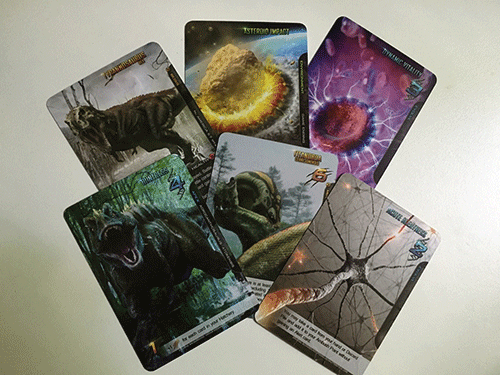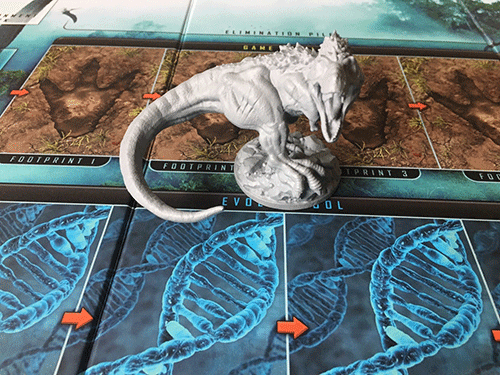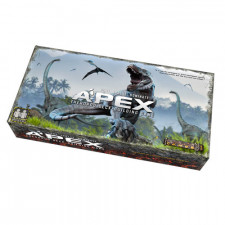Apex: Theropod (2nd Edition) Review
on May 24, 2016
How could I possibly resist a game with such a cool title as Apex: Theropod- let alone the fact that it is about dinosaurs eating each other and evolving to be able to eat bigger dinosaurs. Herschel Hoffmeyer’s take on the deckbuilding game takes quite a few cues from Upper Deck’s Legendary system, but it emerges as something quite different, more detailed and in some ways better than even the best of that series (which would be Legendary Encounters: Alien). But it is also something of a hot mess with a few of the earmarks of a crowdfunded design, including some awkward processes, shaky mechanics and questionable balance. It’s unpolished and a little sloppy, weirdly feeling like a solitaire game with some multiplayer PVP elements bolted on for those who want to play this with up to six players, something I do not recommend in the least.
Everybody takes a Theropod deck, which gives you a suite of exclusive Apex cards representing your particular dinosaur’s unique abilities and characteristics. These go into a Hatchery deck. As usual with the deckbuilding genre, you start out with a seed deck of a few dino carcasses to munch on so that you can buy advantageous cards from the Evolve row to add to your deck. You also get one egg, which lets you draw one card from your deck and also “hatch†one from the Apex deck, which can be bought with those Evolve points. On top of all of that, your starter features a few Hatchlings and a Juvenile of the species you picked. You use these to hunt dinosaurs in the Game Trail to eat and earn points to evolve.

So it’s typical stuff here that we’ve seen a thousand times. But where this game jumps off from that, it gets much more interesting. As dinosaurs come out of the Prey deck, they sometimes have Ambush effects. Some dinos might steal eggs out of your hand and hold them captive. Predators might eat other dinosaurs in the row. Many can actually harm you when you try to hunt them, adding wounds to your deck. And then there are dinosaurs which have an Alert function, which triggers if you have Alert cards in your hand.
These come from setting up ambushes. You can bank up to three of your Apex cards per turn into an Ambush Point spot on your mat to be used later at your leisure- maybe when there is a fat Big Game class dinosaur out that is offering a lot of Evolve points. The trade-off is that setting an Ambush adds an Alert card to your discard pile and it will eventually cycle into your hand. When it is in your hand, you must play it and the Alert effect on any dinosaurs in the trail triggers. Maybe they heard a twig snap and ran off. Or a Stegosaurus adopts a defensive position and becomes harder to take down.
This is all cool stuff, and it speaks to a greater degree of integration between the deckbuilding mechanics and the setting. While playing, you’ll notice little things like how the card behaviors, coupled with environmental effects, create a strong sense of narrative and atmosphere. The strategy of card acquisition is also more compelling than in similar games. The cards you add to your deck come mainly from your own Apex stack and the Evolve row. The animals you hunt just go into a hoard for point-counting. But to get the Apex cards, you’ve got to hatch them and then buy them. Of course, this requires the right Evolve cards and eggs or other effects to put those Apex cards into the Hatchery to make them available for purchase. It’s more complex than most deckbuilders in this regard with some extra layers of combinations, opportunities and limitations.
Now, what’s the point of all of this? In multiplayer, the goal is to beat down the Apex adult dinosaur of the other players. It’s a good brawl for maybe three players. Beyond that, it’s kind of a slog. The solitaire game builds to an eventual Boss fight, where you have a specific nemesis in the deck that appears and you’ve got to engage in a protracted battle that will test your deck’s ability to dish out (and receive) damage. Each Boss also stocks the deck with some specific Minion cards, which tend to be more powerful than the usual prey cards. If the Boss shows up early, you might have to wait until later in the game to face off with them. But the whole thing is on a timer. That asteroid hits, and then everything goes extinct. You’ve got to become the titular Apex Theropod before it’s party over, oops out of time.
I really like this game but it doesn’t play as smoothly as I would like and it has a few idiosyncratic quirks that bother me- and that may bother some players more than they do me. It can be extremely flakey; some games just completely go south a quarter of the way through or they can end with that boss fight going down a whimper. It’s all in the cards. But by and large, I think the arc works well and I’ve had a few games where the boss fight was tense, exciting and could go either way until a last chance cardplay handed me the victory.

The difficulty is scaled based on which theropod deck and boss you pick. The easy-class dinosaurs tend to offer easier combos and simpler effects, along with lower card costs. The moderate and hard ones ramp it all up. And of course, if you outstrip what is in the box there are expansions. I would regard the available expansions as essential because they add quite a bit of variety to it, especially in terms of the Environment, Evolve and Affliction decks. The new dinosaurs are all good too. Unfortunately, this game also was produced under the asinine practice of withholding certain expansion packs for Kickstarter backers, so there are additions that you just can’t buy. It’s unfortunate because I’d like to see everything this unique game has to offer.

 Customer Support
Customer Support  Subscribe
Subscribe 




 Account
Account  Wishlist
Wishlist 

